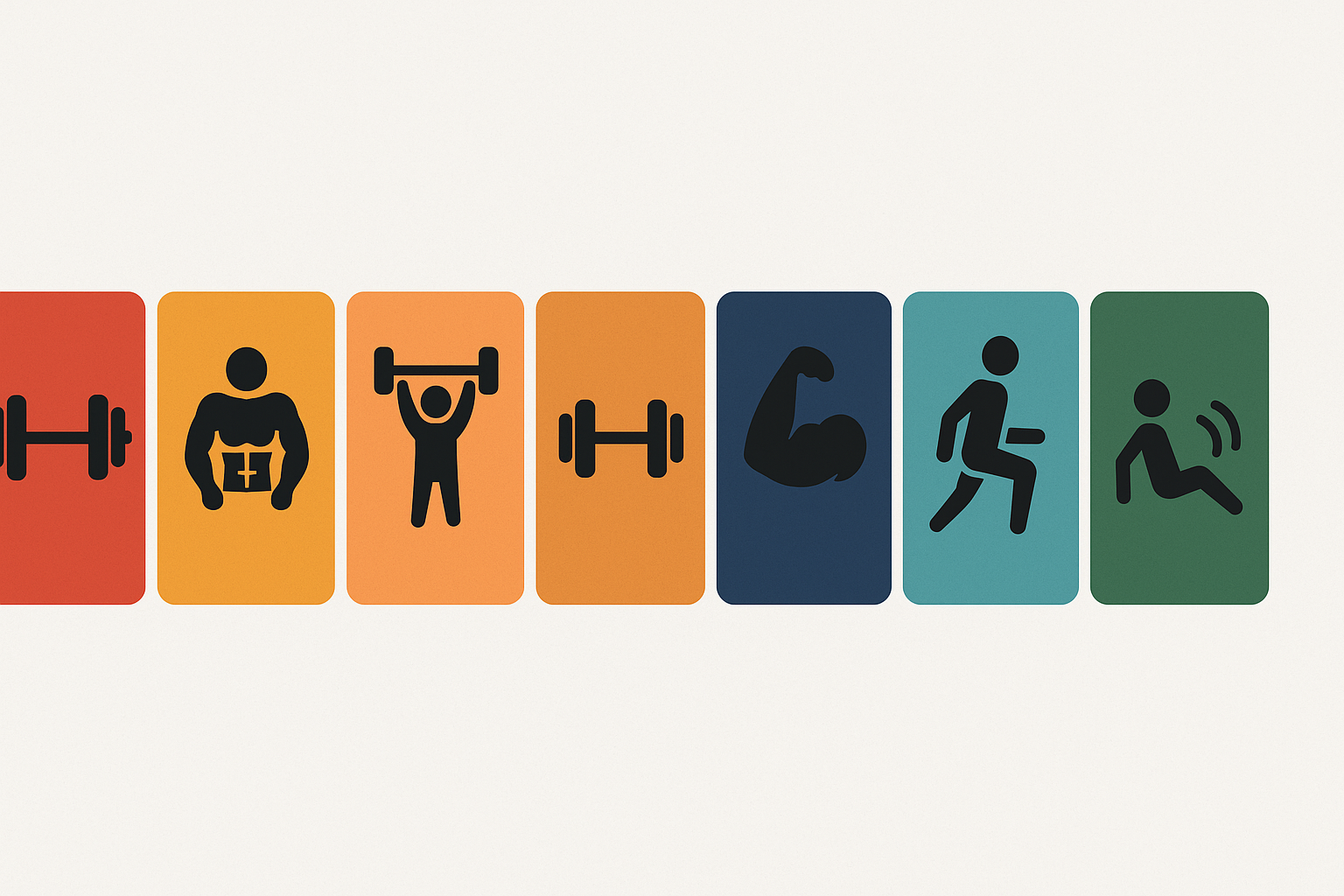Understanding the Muscle-Building Process: Stress, Recovery, and Adaptation
Before addressing the concept of lifting weights everyday, it’s important to understand how muscle actually grows. Strength and hypertrophy result from a cyclical process involving mechanical tension, muscle damage, and metabolic stress. When you perform resistance training, your muscles experience microscopic tears—an intentional form of damage that signals the body to begin repair processes. This response, primarily driven by satellite cell activation, results in the synthesis of new muscle proteins, gradually increasing the muscle’s size and strength over time.

However, this growth doesn’t happen during the workout itself. In fact, it’s during periods of rest—particularly sleep and recovery days—that muscles regenerate and adapt to handle greater loads. This is the crux of the “stimulus-recovery-adaptation” model that underpins most evidence-based training programs. Without sufficient rest, recovery is impaired, potentially leading to stagnation or even regression in performance. The question, then, is whether lifting weights everyday allows adequate time for this recovery-adaptation cycle to take place—or whether it pushes the body into a state of chronic fatigue.
You may also like: The Ultimate Hypertrophy Workout Program for Building Strength and Size

The Case for Daily Lifting: Frequency and Muscle Protein Synthesis
Interestingly, there is a growing body of research suggesting that increased training frequency may have unique benefits for muscle growth—provided volume and intensity are managed appropriately. Muscle protein synthesis (MPS), the process responsible for building new muscle tissue, is elevated for approximately 24 to 48 hours following a workout. Therefore, hitting the same muscle group once every three to four days may not maximize this anabolic window.
By training more frequently, individuals can stimulate MPS more often, potentially leading to greater hypertrophy over time. Several studies support this idea. For instance, a 2016 meta-analysis in Sports Medicine found that training a muscle group twice per week produced significantly greater hypertrophy than training once weekly. While this doesn’t directly imply that lifting weights everyday is superior, it opens the door to exploring higher-frequency training models that might involve full-body or split routines across seven days.
Moreover, athletes with high work capacities, including bodybuilders and Olympic lifters, often train daily without negative consequences. The key differentiator here is how training variables—volume, intensity, exercise selection, and load—are manipulated to avoid systemic overtraining. In controlled conditions, lifting weights everyday can maintain an anabolic environment while gradually enhancing neuromuscular coordination, skill development, and movement efficiency.

Lifting Weights Everyday: Recovery Strategies that Make It Sustainable
While frequent lifting can enhance muscle protein synthesis and motor learning, it’s only sustainable when balanced by strategic recovery protocols. Lifters who train daily must be particularly attuned to their bodies and proactive about recovery modalities. Passive recovery—including quality sleep, nutrition, and hydration—is non-negotiable. Sleep, especially deep sleep, plays a pivotal role in growth hormone secretion and muscle repair. Failing to get seven to nine hours of high-quality rest can quickly derail recovery and undermine training adaptations.
Equally important is nutrition. Resistance training increases the body’s demand for macronutrients—particularly protein, which provides the amino acids necessary for muscle repair. For individuals lifting weights everyday, a daily protein intake of 1.6 to 2.2 grams per kilogram of body weight is generally recommended. In addition, ensuring adequate caloric intake from whole-food carbohydrates and healthy fats supports glycogen replenishment and hormonal balance.
Active recovery methods also play a vital role. These include foam rolling, stretching, light aerobic activity, massage, and even contrast therapy (alternating hot and cold). Such techniques can mitigate delayed-onset muscle soreness (DOMS), increase circulation, and enhance parasympathetic nervous system activation—helping the body shift into a recovery state even amid frequent training.

Can I Lift Weights Every Day Without Overtraining?
One of the most common concerns among lifters is whether lifting weights everyday inevitably leads to overtraining. The truth is more nuanced. Overtraining syndrome—a clinical condition characterized by decreased performance, mood disturbances, and physiological maladaptations—results not from daily training per se, but from chronic exposure to high intensity and volume without sufficient recovery. In other words, it’s not how often you train that matters most, but how intelligently you program that training.
Daily lifting does not require maximal intensity every session. A well-designed weekly split might include high-intensity days (e.g., heavy squats or deadlifts), moderate-volume hypertrophy work, and low-intensity recovery sessions with light resistance or technique refinement. Autoregulation—adjusting workout intensity based on readiness—can also prevent cumulative fatigue. Tools like the Rate of Perceived Exertion (RPE) or Reps in Reserve (RIR) offer lifters a way to gauge effort and adapt on the fly.
Additionally, periodization—strategically organizing training into blocks of varying focus—enables lifters to integrate recovery into the long-term plan. Deload weeks, where volume or intensity is reduced, offer a much-needed physiological reset. So while lifting weights everyday is possible, it requires careful attention to programming, monitoring, and lifestyle habits to prevent overreaching and its more severe cousin, overtraining.

The Neurological Adaptations of Frequent Lifting
While hypertrophy tends to dominate the discussion around strength training, neurological adaptations are equally important—especially for lifters aiming to build maximal strength. Neural efficiency refers to the brain and nervous system’s ability to activate muscle fibers quickly and effectively. These adaptations are highly sensitive to frequency. Practicing lifts more often can enhance inter- and intramuscular coordination, improve motor unit recruitment, and sharpen movement patterns.
For example, Olympic lifters frequently train complex movements such as the snatch or clean and jerk every day—not to build massive muscles, but to refine technique and develop explosive strength. Similarly, novice lifters often benefit from frequent exposure to fundamental movements like the squat, bench press, and deadlift. In these cases, lifting weights everyday acts as both skill practice and strength conditioning, leading to accelerated learning and improved performance.
Moreover, frequent training can strengthen mind-muscle connection—a critical yet often overlooked element of hypertrophy. By repeatedly cueing specific muscles during compound and isolation exercises, lifters learn to contract with greater intensity and precision. This neural connection can amplify training efficiency and reduce compensatory patterns, further reinforcing the benefits of lifting frequently when done mindfully.
Frequently Asked Questions About Lifting Weights Everyday
Can lifting weights everyday improve mental focus and emotional well-being?
Yes, lifting weights everyday can significantly impact mental focus and emotional health when approached with balance and mindfulness. Regular resistance training stimulates the release of endorphins, which are natural mood enhancers that help reduce symptoms of anxiety and depression. Moreover, the consistent structure of daily workouts can foster a sense of discipline and accomplishment, both of which are powerful contributors to self-efficacy and motivation. However, the psychological benefits depend on avoiding burnout—incorporating variety, rest techniques, and deload days prevents lifting from becoming mentally exhausting. It’s also important to listen to your mood and mental readiness as closely as you would your physical cues, especially when deciding whether to push through or ease back on a session.
What are some creative ways to prevent boredom while lifting weights everyday?
One of the biggest challenges of lifting weights everyday is keeping your routine mentally stimulating. To prevent boredom, lifters can rotate training modalities—such as incorporating strongman movements, resistance bands, kettlebells, or bodyweight circuits—to refresh neural engagement and enhance different movement patterns. Additionally, using unconventional rep schemes like pyramids, drop sets, or time-under-tension protocols can reinvigorate otherwise familiar exercises. Changing the training environment, such as lifting outdoors or switching to a new gym, also contributes to novelty and motivation. For tech-savvy athletes, using apps that gamify progress tracking or integrate virtual coaching adds another layer of engagement that encourages consistency and creativity.
How does lifting weights everyday affect joint health over time?
When properly managed, lifting weights everyday can actually support long-term joint health by improving the strength of connective tissues and promoting synovial fluid circulation. However, repetitive stress without sufficient variation in movement patterns can lead to overuse injuries, especially in joints like the shoulders, elbows, and knees. Incorporating mobility drills, eccentric-focused work, and stability exercises is essential for joint preservation. Using periodized programs that cycle high-load and low-load phases allows joints to recover while still maintaining performance. It’s also advisable to rotate grip angles, stances, and implements (e.g., using trap bars instead of straight bars) to distribute joint stress and prevent chronic irritation.
Can lifting weights everyday enhance metabolic flexibility and energy utilization?
Yes, consistent resistance training can improve metabolic flexibility by teaching the body to efficiently switch between carbohydrate and fat utilization for energy. This is especially true when the training includes varying intensities—from high-rep hypertrophy work to heavy, low-rep strength sessions. Lifting weights everyday keeps muscles insulin-sensitive and helps regulate blood glucose levels, which are crucial factors for metabolic health. Additionally, daily resistance training has been associated with better mitochondrial density, improving cellular energy production over time. To maximize these metabolic benefits, lifters should ensure adequate sleep, consume nutrient-dense whole foods, and avoid overtraining, which can have the opposite effect on metabolism.
Is lifting weights everyday safe for older adults or those with chronic conditions?
For older adults or individuals managing chronic conditions, lifting weights everyday can be safe and beneficial, but only when personalized to accommodate their specific needs and limitations. The key is prioritizing movement quality over load and emphasizing joint-friendly, low-impact exercises such as machine-based movements, resistance bands, or light dumbbells. Daily lifting for these populations should include functional movements that enhance balance, mobility, and posture to support independent living. Importantly, rest intervals and exercise intensity must be tailored to avoid systemic fatigue or injury. Consulting a qualified healthcare provider or exercise physiologist ensures that the routine is both safe and optimally effective for long-term wellness.
How does lifting weights everyday affect sleep quality and circadian rhythms?
Interestingly, lifting weights everyday can help regulate circadian rhythms and improve sleep quality, especially when sessions are performed at consistent times. Resistance training enhances the body’s ability to fall into deeper stages of sleep, which are vital for muscle recovery and hormonal balance. However, timing matters—training too late in the evening may elevate cortisol and delay melatonin production, making it harder to wind down. On the flip side, morning or early afternoon sessions can reinforce healthy sleep-wake cycles. Including a wind-down routine post-workout—such as stretching, hydration, and screen-free time—also supports better sleep hygiene in daily lifters.
What is the impact of lifting weights everyday on long-term motivation and fitness identity?
Engaging in lifting weights everyday can transform fitness from a task into an integral part of one’s identity, enhancing intrinsic motivation. Over time, the act of showing up daily reinforces personal discipline and builds a sense of ownership over one’s health journey. However, this strong identification with training can also become a double-edged sword—if not balanced, it may foster all-or-nothing thinking or guilt during unavoidable breaks. Lifters should regularly revisit their goals, celebrate small wins, and include mental flexibility in their fitness philosophy. In doing so, lifting becomes a sustainable, rewarding lifestyle rather than a rigid obligation.

How can I structure my weekly split to succeed with lifting weights everyday?
For those committed to lifting weights everyday, a well-structured weekly split is essential to avoid overuse and maximize recovery. A popular strategy is the high-low system—alternating between high-intensity compound lifts and lower-intensity accessory or mobility work. For example, a weekly rotation might include upper/lower splits, followed by technique-focused or hypertrophy days, ensuring no single muscle group is overworked. Integrating one or two “active recovery” lifting days, using very light resistance or low-impact movements, can help maintain the habit while promoting healing. Tracking performance metrics and fatigue markers will further guide adjustments to ensure long-term consistency and progress.
What role does mindset play in successfully lifting weights everyday?
Mindset is arguably the most underrated component of successfully lifting weights everyday. A resilient mindset supports adherence through physical discomfort, mental fatigue, and life’s inevitable stressors. Daily training instills routines that reinforce delayed gratification and grit—qualities that translate beyond the gym into professional and personal success. However, mindset should not equate to rigid discipline alone. Lifters must cultivate self-compassion and adaptability to pivot when the body signals a need for rest. This nuanced mental approach prevents burnout and creates a healthier, more sustainable relationship with daily fitness pursuits.
What are the future trends in training that may support lifting weights everyday?
Emerging fitness technologies are poised to make lifting weights everyday more efficient and personalized. Wearable devices now track readiness indicators like heart rate variability (HRV), providing data-driven insights into when to push and when to recover. AI-powered fitness apps offer adaptive programming that evolves with user performance, minimizing guesswork. Recovery tech, such as infrared therapy and pneumatic compression systems, is becoming more accessible, allowing daily lifters to optimize muscle repair. Additionally, research into hormonal periodization and chronobiology may influence future training prescriptions based on individual circadian biology. As these innovations mature, lifting weights everyday will become an increasingly informed, customized practice for a broader population.
Conclusion: The Balanced Path to Daily Strength and Muscle Gains
Lifting weights everyday is not merely a bold choice—it’s a disciplined pursuit that demands a refined understanding of training science, recovery, and personal limitations. It challenges conventional wisdom while offering a unique pathway for those seeking relentless progress. When approached with respect for the body’s signals, a commitment to quality nutrition, and a willingness to adapt, daily lifting becomes more than a habit—it becomes a craft.
Whether you are experimenting with this approach for the first time or fine-tuning an advanced protocol, remember that success lies not in perfection but in persistence. The body thrives on consistency, variety, and intelligent effort. So if you’re wondering, “Can I lift weights every day and still recover?” the answer may very well be yes—so long as you lift with purpose, recover with intent, and train with both heart and science as your guide.
Further Reading:
I Lifted Every Day For A Month – Here’s The Best Way To Do It
What Really Happens to Your Body When You Lift Weights Every Day





